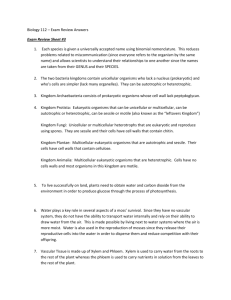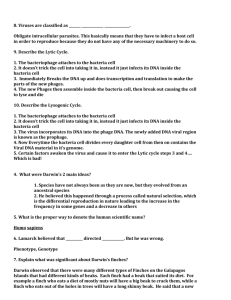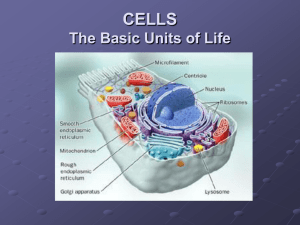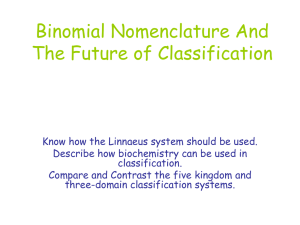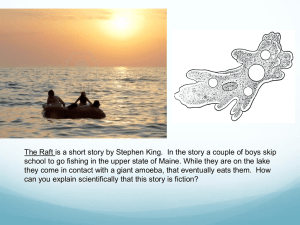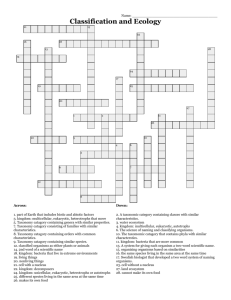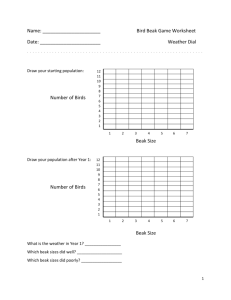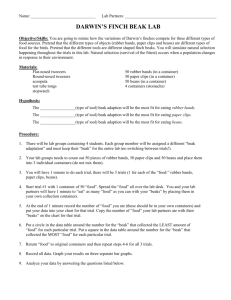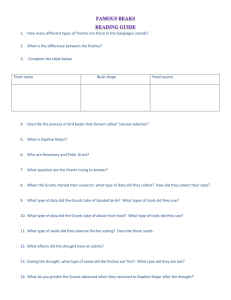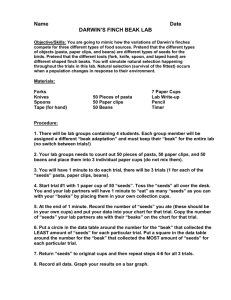File
advertisement
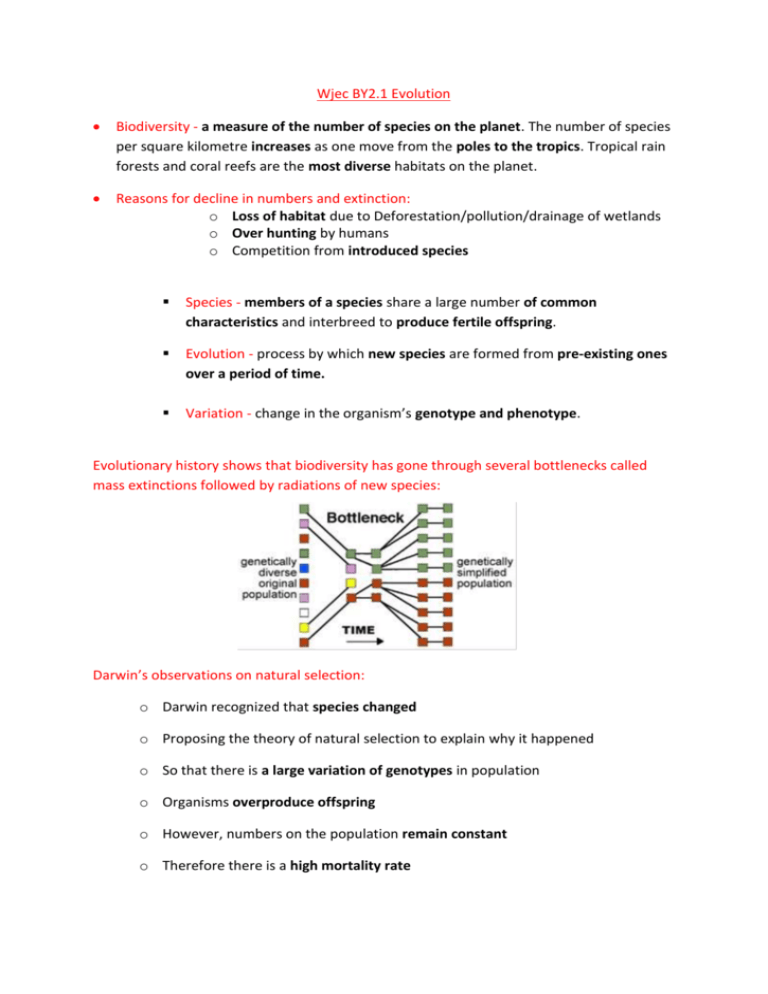
Wjec BY2.1 Evolution Biodiversity - a measure of the number of species on the planet. The number of species per square kilometre increases as one move from the poles to the tropics. Tropical rain forests and coral reefs are the most diverse habitats on the planet. Reasons for decline in numbers and extinction: o Loss of habitat due to Deforestation/pollution/drainage of wetlands o Over hunting by humans o Competition from introduced species Species - members of a species share a large number of common characteristics and interbreed to produce fertile offspring. Evolution - process by which new species are formed from pre-existing ones over a period of time. Variation - change in the organism’s genotype and phenotype. Evolutionary history shows that biodiversity has gone through several bottlenecks called mass extinctions followed by radiations of new species: Darwin’s observations on natural selection: o Darwin recognized that species changed o Proposing the theory of natural selection to explain why it happened o So that there is a large variation of genotypes in population o Organisms overproduce offspring o However, numbers on the population remain constant o Therefore there is a high mortality rate o Because only those individuals with beneficial alleles have a selective advantage e.g. white fur in arctic o Can withstand selection pressures i.e. a factor which increases the chances of a beneficial allele being passed onto the next generation e.g. competition, predation, disease o These individuals then reproduce o Offspring are likely to inherit the beneficial alleles, therefore characteristic o This process repeats generation after generation o Therefore the beneficial allele frequency increases within the gene pool o e.g. Darwin found adaptive radiation in the finch population of the Galapagos islands, which describes the evolutionary diversification of many species from a single common ancestor In 1832 Darwin travelled to South America, aged 22, to carry out a scientific study – studied the finches on the Galapagos Islands. He suggested a common ancestor finches reached the islands by chance and developed and evolved from this finch so over time each finch had a different beak adapted to exploit a particular food supply. (Selective pressure) The variation of beak sizes can be represented in normal distribution curves. The curves below compare the variation in beak sizes found on: o A large island where 2 species of finch coexist o A small island where only one species exists Key G.fuliginosa G.fortis Large island Small island Frequency Frequency 0 5 10 15 Beak size mm 20 0 5 10 20 Beak size mm The beak size on the small island shows: o o o o Greater variation With a higher mean Because there is less competition for food (with other finches) Therefore there is a smaller selective pressure Classification: Helps understand relationships between ancestors o Phylogenetics: Based on Evolutionary History of the organisms It shows the Ancestry of groups or Points of Divergence E.g. mammals and birds are more closely related than fish Organisms are classified on the basis of similar or shared characteristics e.g. phenotype/DNA Fingerprinting) DNA Fingerprinting can be used to assess how related organisms are i.e. more closely related, fewer number of differences / high number of shared genes Evidence for Common ancestry and natural selection: Closely related species are recognised by their similar morphology (body structure), e.g. the fossil record o Homologous structures like that of the pentadactyl limb in vertebrates can be used as evidence to show that organisms evolved from common ancestors. o Analogous structures such as the wings of a bird and insect are not an indication of relatedness: Homologous structure - pentadactyl limb. Analogous structures - dorsal fin (shark and dolphin) Biochemical techniques o Compare the sequence of bases in DNA of genes (DNA Fingerprinting) - the more similar the sequence the more closely related the species *N.B. The best/most accurate technique for establishing relatedness DNA is most similar, so most closely related o Compare the sequence of amino acids in proteins – the more similar the sequence the more closely related the species The most commonly used classification is: o Kingdom King o Phylum Prawn Chordata/Vertebrata o Class Curry Mammalia o Order Or Primates o Family Fat Hominidae o Genus Greasy Homo o Species Sausages sapiens e.g. Animalia Binomial system: The last two taxa, Genus and species are used to give the organism a name:o Homo sapien = man o Rattus norvegicus = Brown rat o Rattus rattus = Black rat Binomial system is used to avoid confusion of local common names and different languages – uses the Latin name Kingdom Phylum Animal Chordata (Non-chordata) Arthropods Class Millipedes/ Spiders Centipedes Characteristics of the 5 Kingdoms (excluding viruses): Animal Kingdom e.g. dog, spider, starfish Eukaryotic cells Heterotrophic feeding Multicellular Specialised organ systems Nervous system Cells do not have cell walls Insects Annelids Crustacea Plant Kingdom e.g. tree, daisy Eukaryotic cells Autotrophic feeding (Light energy converted to chemical energy) Multicellular Specialised structures e.g. leaves, stems , roots Cells have cellulose cell walls Fungi Kingdom e.g. mushrooms, yeast Eukaryotic cells Made up of hyphae threads forming a mycelium Cells have Chitin cell walls Heterotrophic feeding (often saprophytic) Reproduce using spores Protoctist Kingdom e.g. slime moulds, algae Eukaryotic cells Unicellular organisms that are Heterotrophic or Autotrophic Multicellular organisms are autotrophic (Seaweed) No specialised structures Have cell walls Prokaryote Kingdom (Bacteria) e.g. salmonella Much smaller than Eukaryotic cells Most are unicellular Murein Cell wall (not made from cellulose) No nucleus (or any membrane bound organelles) Loop of DNA (not Linear) Smaller Ribosomes than Eukaryotic cells (70S) Saprophytic/Autotrophic feeders More characteristics: Annelids e.g. earthworms, leeches, lugworms. o a long, thin segmented body, the segments being visible externally as rings o a closed circulatory system i.e. blood vessels o a hydrostatic skeleton and fluid filled body cavity o a head end with a primitive brain and a nervous system running the length of the body o a thin permeable skin, through which gaseous exchange occurs o a closed circulatory system containing an oxygen carrying pigment e.g. haemoglobin Arthropods e.g. millipedes and centipedes, crustaceans, spiders and insects. o a body divided into segments o a body further divided into head, thorax and abdomen o a well-developed brain o a hard outer exoskeleton made of chitin o paired jointed legs o an open circulatory system o a cavity which surrounds the body organs called (haemocoel) Two important evolutionary developments are: o jointed legs - modified to perform a variety of functions, including walking, swimming, jumping, feeding, reproduction and where present, ventilation of the gills. o exoskeleton - the outermost layer of cells of the body secretes a thick cuticle, which consists mainly of chitin. This performs several functions: protection of internal organs protection from predators provides a point of attachment for muscles support -for small animals a hollow tubular structure surrounding the body provides greater support than a solid cylindrical rod within it (an endoskeleton as in vertebrates) made from the same quantity of material in most terrestrial arthropods the exoskeleton is covered with a layer of wax which reduces water loss. The one main disadvantage of the exoskeleton is that it is fixed in size and does not grow with the animal. In order to grow an arthropod must periodically shed its exoskeleton (ecdysis). This leaves the animal especially vulnerable as the new exoskeleton hardens. Chordate features: (all have vertebral column/backbone and well developed brain enclosed in cranium) Fish- scales, fins and gills. Amphibians- partly terrestrial and partly aquatic. Soft, moist skin. The eggs are fertilised externally in water, where they also develop. Young are aquatic. Reptiles- mainly terrestrial and have dry skin with scales. They have lungs. The eggs are fertilised internally, covered with a shell and laid on land. Birds- they can fly and have feathers. Forelegs develop as wings. They have lungs and their eggs have hard shells. Mammals- have skin with hair. Young are born alive and are fed on milk. They have lungs. They are subdivided into 2 groups: o Marsupials- young are born at a very immature stage and develop in femals pouch. Placentals- young undergo considerable development in the mother's womb. o
